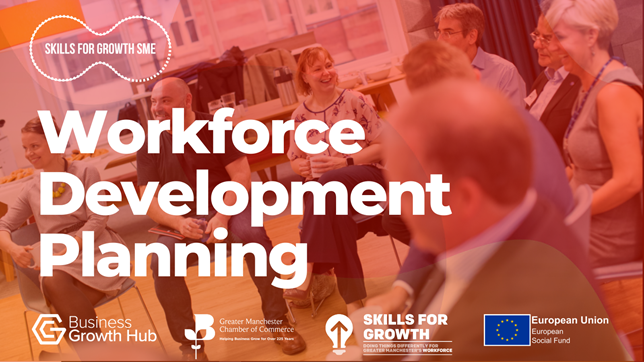Dawn has been with the Business Growth Hub since September 2014 and is responsible for the design, delivery and evaluation of the People, Skills & Talent Programme which include the Executive Development Programme, Workforce Development, Inclusive Growth, Mentoring, National Be the Business Mentoring for Growth Programme and Skills for Growth – SME Support.
Workforce Development Planning – What is it and how to make it work for you
While many organisations realize the need for better planning, most still lack the tools and capabilities to effectively manage and execute the strategic steps necessary to drive significant business results.
Agile workforce planning shapes the employee experience in significant ways. It also helps companies form teams that work well together for impactful, long-term results, improves investor relations, and enhances talent management capabilities.
People are at the centre of effective workforce planning. When a company plans with its people top of mind, it prioritises and caters to their wellbeing and, ultimately, improves the employee experience.
Workforce planning can help your organization gain business agility through the efforts of engaged employees and their unique, individual talents. That starts with having flexible workforce plans that are tailored to their experiences and needs.
Analysing your workforce helps you determine how to move toward higher productivity and profitability. This ensures that your hiring strategies meet business requirements and that your workforce plans coincide with your growth plan.
4 basic principles of workforce planning
-
Right people
Some companies rely heavily on the addition of new team members to achieve their goals. In these instances, it would be necessary for them to expand their workforce to process their workloads.
In the new remote business world, regional barriers have dissipated, making it possible to find the best talent, regardless of where they live. Expand your talent acquisition strategy beyond your local area to find the right people for your team.
Things to consider:
- A national talent search
• Factors that affect staffing needs
• Productivity
-
Right skills
Knowing exactly which competencies your company requires from its talent is critical to meeting future challenges and most effectively filling skills gaps. Identifying the experience levels that support strategic competencies is vital for translating hiring into strategy and turning business models into long-term results.
Things to consider:
- Key skills needed throughout the organisation
• Impact of skills on your strategy and business model
-
Right place and time
Continued growth requires placing the right people in the right positions at the right time, and having the right positions to place them in. Accomplishing this requires ensuring employees are optimally distributed throughout the company.
It also means companies must establish clear business goals to ensure they’re hiring team members equipped to help meet current and future company objectives.
Things to consider:
- Alignment of talent distribution and company needs
• Adjustment of hiring strategy to meet business objectives
-
Right cost
Plan for direct and indirect costs you can expect to incur while hiring, including costs for job ads, hours spent on applicant interviewing, new employee salaries, benefits, insurance, etc.
Understanding what these costs look like will keep your team within budget. It will also ensure you’re optimizing costs by securing the right talent, only when those specific skills are needed.
Things to consider:
- Focus on strategies to optimize costs related to talent
• Planning for direct and indirect hiring expenses
• Budgeting for only the talent and skill sets your company needs
These principles should act as the foundation of your strategic workforce planning.
Workforce development helps to identify current trends and forecast future workforce structures that can help to meet service delivery requirements. This in turn can lead to the development and implementation of skills sets to raise labour productivity and increase social inclusion.
Workforce planning provides managers with a strategic basis for making human resource decisions. It allows managers to anticipate change rather than being surprised by events, as well as providing strategic methods for addressing present and anticipated workforce issues

What is the most important part of workforce planning?
Identify relevant strategies for focused people development. The very premise of workforce planning is that business changes, and because business changes, people need to change. Figuring out talent gaps and plans to fill those gaps is a core function of workforce planning.
As you work toward your goals for growth, here are four reasons your business should focus on workforce planning and begin to realize its many benefits.
- Balance External Hiring with Internal Moves – Bringing in external talent is a great way to bring new skills into your business, but hiring internally comes with a heap of benefits including reduced hiring costs, candidates are already familiar with the company, boosts company loyalty, faster hiring process and more.
- More Effective Onboarding – Ensure new recruits make as many internal contacts as possible during the first month or so after they’ve joined so they can find their bearings within the company and gain valuable insights going forward.
- Better Anticipated Training, Compensation, and Benefit Needs – Offer training and career development opportunities for employees who want the ability to grow within their role at the company. Workplace training will also increase overall productivity and quality of work as employees will be able to perform their roles more effectively.
- Improved Employee Engagement – Employees need to feel recognised and valued within a company for them to be engaged and motivated at work. After hiring new recruits, invest in their personal and career development by giving them the opportunity to grow, and they will reciprocate that investment by being more productive and producing higher quality work.
Skills for Growth SME Support can work with your business to explore all of the above and to support you in identifying your current and future skills gaps and needs to allow your business to continue to flourish and grow – we can work with you on your employees individual skills analysis and where improvements can be made in line with your business goals and objectives. We will then use our GM Skills Map to source the best training support/provision that meets your needs and where possible source this fully or partly funded as a priority.

